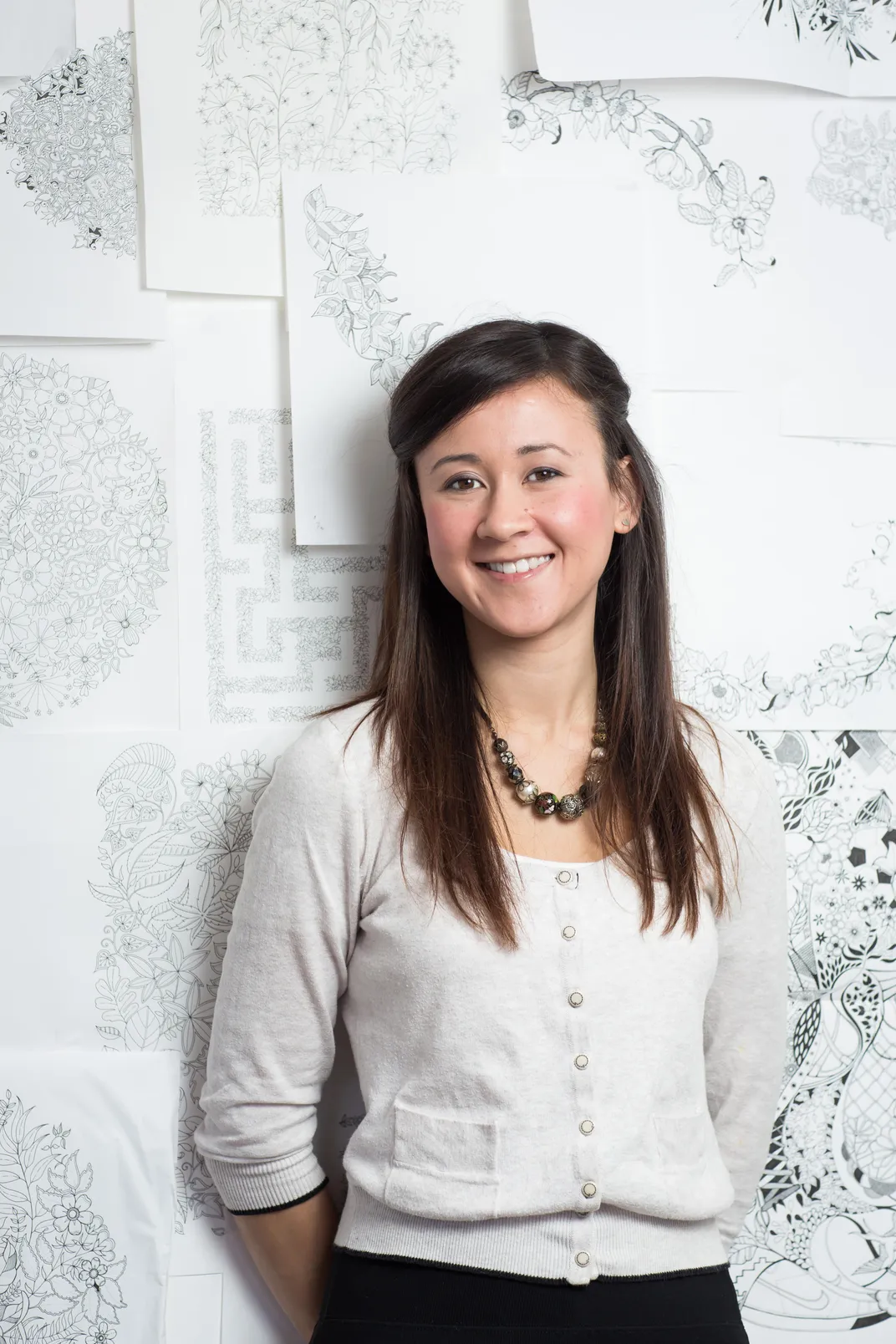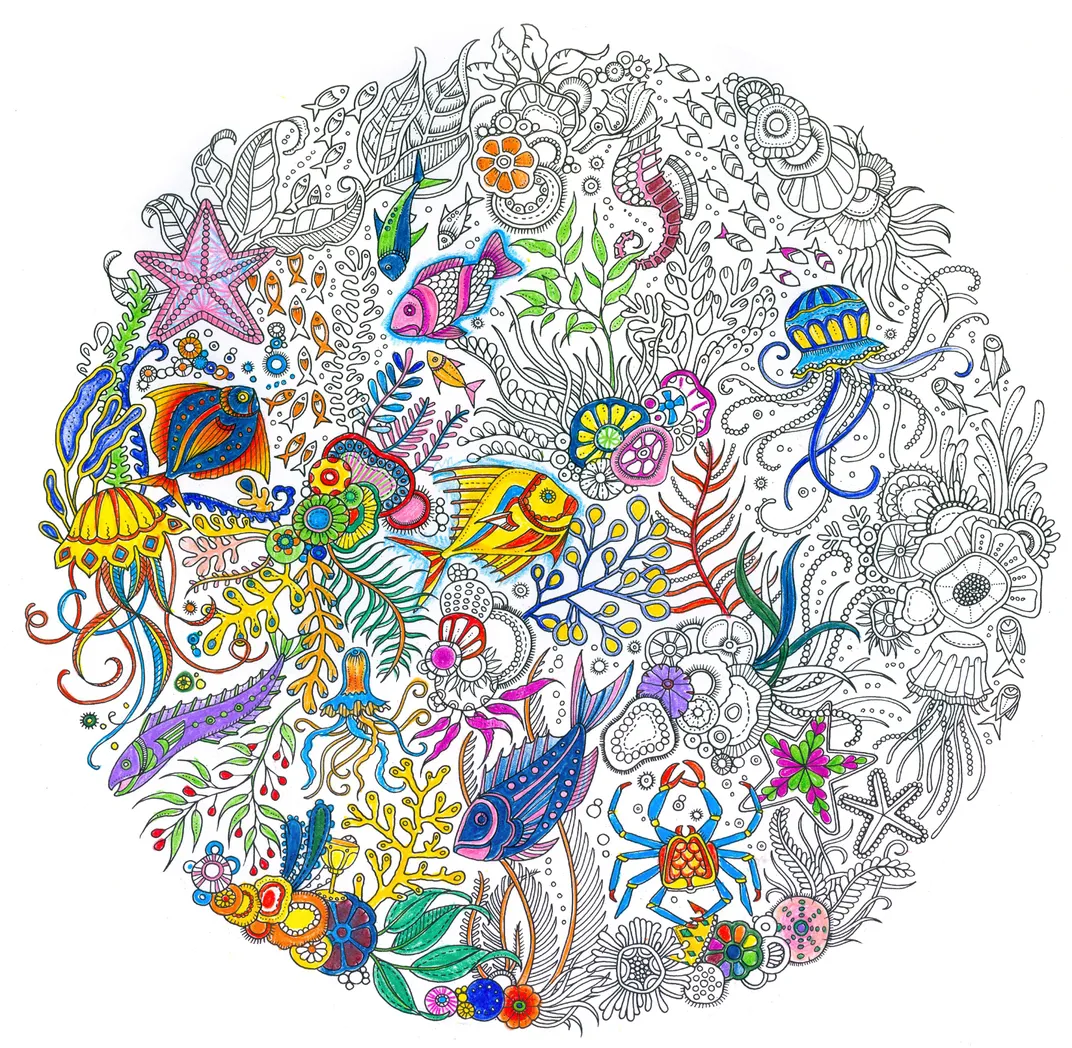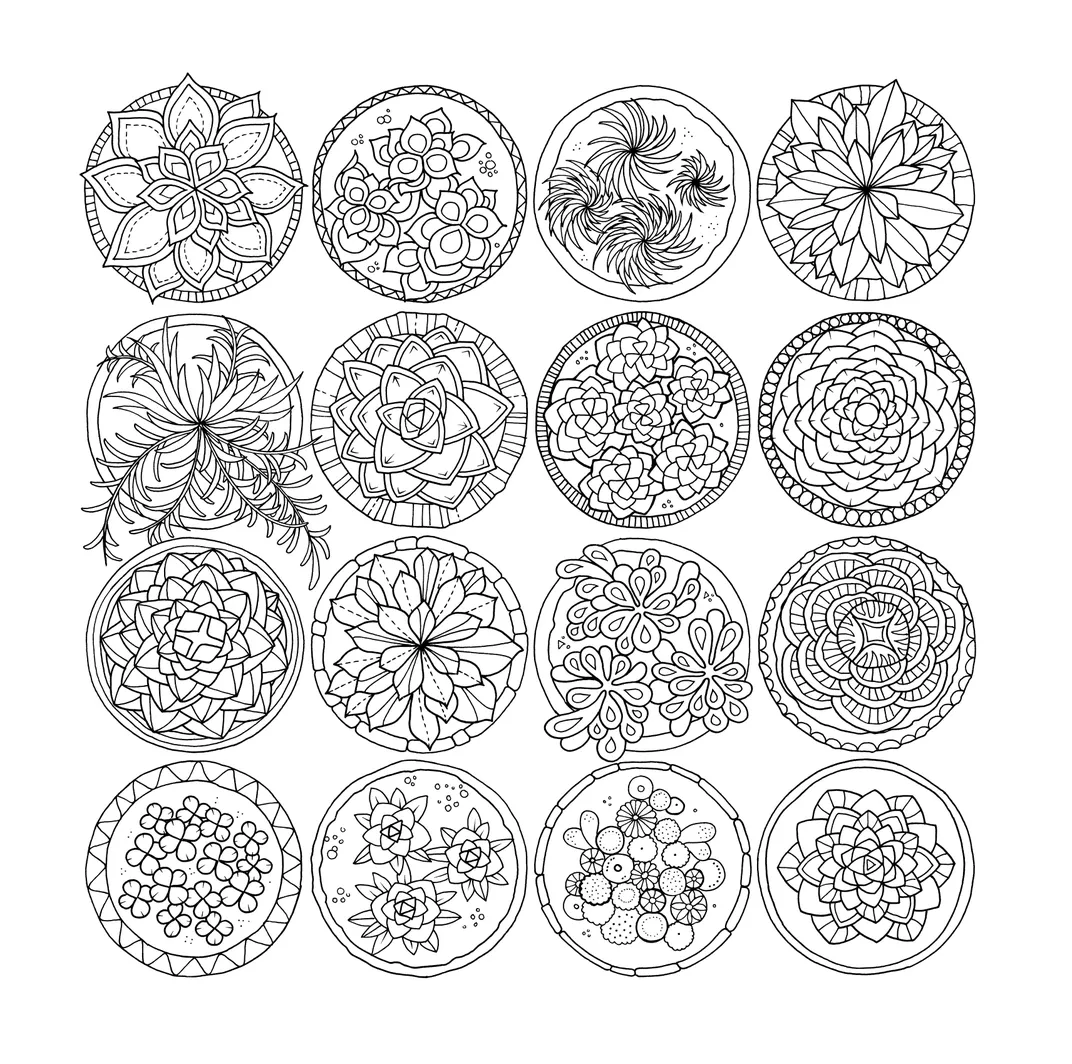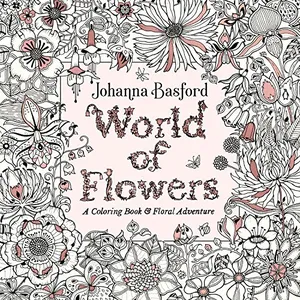The Artist Who Made Coloring Books Cool for Adults Returns With a New Masterpiece
Johanna Basford, whose fanciful, hand-drawn illustrations launched a worldwide craze, is back with flying colors
:focal(407x148:408x149)/https://tf-cmsv2-smithsonianmag-media.s3.amazonaws.com/filer/6b/f3/6bf3f88a-edcc-46af-a58d-38f181b3b465/hero-illustration-v3.jpg)
Not far from Johanna Basford’s home on the northeast coast of Scotland lies a parabola of golden-ocher sand where the proportion of sky to land is unlike anything you’ll likely see outside of a Bertolucci film. A wildlife Eden, this stretch of heathland serves as a motorway for birds that wheel in from the Arctic—red-throated divers, pink-footed geese and long-tailed ducks with cream and chocolate plumage. During the summer months, strong gusts combined with the powdery sand can ruin a perfectly good sandwich.
Throughout the winter the shoreline is invariably a few degrees warmer than inland. On this biting afternoon, the sea changes shades with each shift of cloud and rain and wind. Basford sits in a pub in nearby Ellon, her hands wrapped around a cup of English breakfast tea, comparing the colors of nature with those found in a 120-pack of Crayola crayons. “As a child, I used to think the yellow and the white were just a bit redundant,” she says in a soft burr that tends to drift upward at the end of a sentence, making statements sound like questions. “But I don’t think I had any specific favorite colors. I do remember the day that I learned that if you heated up the crayons, you could bend them. And that was a revelation.”
The 35-year-old Basford is something of a revelation herself. She’s a pioneer—possibly the pioneer—of the modern adult coloring book, a childhood pastime retrofitted for frazzled grown-ups. When the genre stormed the best-seller lists five years ago, Basford’s debut, Secret Garden, led the charge. It’s filled with filigreed visions of ferns and flowers and frogs rendered delicately in black and white, all drawn by hand. “I had a hunch that there were adults out there who would love to return to the days of finger-paints and carefree playing with color,” says Basford, a freelance illustrator whose initial pitch to a publisher was met with baffled silence. “The first print run was a tentative 13,000 copies. I was fairly certain my mum was going to have to buy a lot.”
Secret Garden turned out to be a runaway sensation, selling 12 million copies worldwide, including nearly four million in China over less than three months. Translated into 45 languages, it was also a huge hit in Brazil (1.6 million), the United States (1.7 million) and France (350,000), where it outsold the country’s most popular cookbooks. “I love the idea of chic Parisian ladies putting down their saucepans in favor of gel pens,” Basford says. In South Korea, sales of 1.5 million suggest that nearly 3 percent of the population owns a copy. By 2016, adult coloring books had their own dedicated sections on Amazon and in big-box stores. Demand caused worldwide pencil shortages, and Faber-Castell, the planet’s biggest wooden-pencil manufacturer, had to add shifts at its Bavarian factory to keep pace with global demand. “Our success led to copycats, pirated copies and coloring apps,” says Debra Matsumoto of Secret Garden publisher Laurence King. “Publishers hurried to push out coloring books. All sorts of versions were on the shelves: branded ones to religious themes and type-based profanity.”

Laws of sales are generally less immutable than laws of physics, but the publishing industry does fit Newton’s law of gravity rather well—what goes up must sooner or later come down. Over the last two years, the white-hot adult coloring books trade has cooled considerably. Some blame market over-saturation; others, Amazon, which may have scooped up hundreds of coloring book self-publishers. “One of the things that the market has taught us is that there’s now a permanent category of adult coloring book buyers,” says Tiffany Hill, crafts editor at Fox Chapel, home to more than 150 titles. “The coloring market has changed, but it’s here to stay.”
Indeed, Basford’s seventh book—World of Flowers—comes out in October with an initial print run of 100,000. “I’m on a mission to make the world a happier, more creative place through coloring,” she says.
As Mother Earth sweats with anxiety, stressed-out men and women have formed coloring clubs and joined online coloring forums where they meet to undergo what Basford calls digital detox. “Coloring is an analog activity,” she says. “You’re not gazing at your iPad. You’re not distracted by the constant chatter of Twitter or the lure of Facebook. You’re unplugging.”
World of Flowers: A Coloring Book and Floral Adventure
This book invites you to travel the world and beyond into fantastical realms, discovering exotic blooms and extraordinary plants along the way.
A self-described “ink evangelist,” Basford is a contagiously enthusiastic spirit. Each minute in her company increases the impression of a quick, observant intelligence, a strong sense of humor seasoned with irony, and a background of wide reading in botany. As it turns out, her grandfather was head gardener at Brodick Castle on the Isle of Arran off the southwest coast of Scotland. “I spent summer and Christmas holidays wandering in the wild woods and the castle grounds,” she recalls. “I have vivid memories of the formal walled garden with its precision-planted flower beds, honeysuckle-clad pergolas and, at the center, a gorgeous sundial. Outside the walls lay a half-hidden summer house lined with pine cones, ponds with lily pads wide enough to stand on, hidden nests of bumblebees, and acres and acres of trees peppered with blossoming pink azaleas and purple rhododendrons. I’d play amongst their roots and gnarled stems.”
Those beguiling moments in the Ayrshire countryside found their way into imagery of flora, fauna and treehouses in Secret Garden and its follow-up, Enchanted Forest. And likewise her grandfather’s horticultural encyclopedias, which she’d inherited when he died in 1997. “Those reference books detail many weird and wonderful species,” she says. “In my work, I’ll often take a leaf from one plant, a petal from another and possibly a seedpod from a third and combine them to create a fanciful botanical hybrid.”
Her knowledge of creatures of the deep—the subject of her third book, Lost Ocean—comes from her parents, marine biologists (he from England, she from British Guiana) who ran a salmon and trout farm outside Aberdeen. “I have a sister named Katrina,” says Basford. “If we wanted to see Mum and Dad, we had to go outside and help with the farm.” The girls would feed the fish, rake the ponds and puddle about in the burn searching for tadpoles. As teenagers, they passed the time on research vessels and aboard fishing boats that dragged for herring and mackerel. “Katrina and I used to scruff it about with big jars of pickled what-have-you,” she says. “We just thought that was normal.” When Johanna met her husband, he was a deckhand on a North Sea trawler.

Drawing was all Basford ever really wanted to do. She drew on pretty much anything, including, at age 4, the walls of her home with the tar paint her dad used to seal the undercarriage of the family Subaru, the one held together with duct tape. “I think I was 4,” she says. “That didn’t go down especially well.” Drawing on her kid sister wasn’t allowed either. “I don’t remember ever really getting into trouble, which puts me in a funny position now because when I see Evie, my 3-year-old, going for the wall with a crayon, my first instinct is, ‘Hey, don’t do that!’ On the other hand, I don’t want to curb her creative passion. Which is why I tell her, ‘Well, let’s see if we can paint some paper.’”
Basford’s coloring books represent a triumph of unpretentious rural aesthetics within a cultural milieu that often favors the urban and urbane. Her free-range childhood lacked a computer and, more or less, a TV. She built caves, battled monsters, used her imagination. Even today, in a world of Daedalean graphics tablets, Basford prefers pens and pencils to pixels. “Digital work is amazing and I’ve got so much respect for those artists, but to me it’s a little bit cold and clinical and there’s no heart to the lines,” says Basford, who only uses her Mac to erase tea splotches and mistakes made when the dog sneezed under her desk and her pen went crazy. “I love the slightly imperfect circle, the little flaws in a flower petal that makes it unlike the next. I’ve always loved the disparities of the natural world. I’d never do a coloring book based on architecture or portraiture or purely abstract forms. For me, they lack a sense of enchantment.”
Much the same sense of magic and wonder informs one of the earliest-known prototypes for the coloring book. Published in two parts in 1612 and 1622, British engraver William Hole created a series of maps to illustrate Michael Drayton’s 15,000-line poem Poly-Olbion. Drayton was a drinking buddy of Shakespeare, and his vast poem toured England and Wales, county by county, evoking the topography and legends along the way. Hole’s surreal uncolored maps—crowded with monsters and myth—transmogrify elements of the natural world, woodlands morphing into huntresses, rivers changing into water sprites. Because the paints used in 17th-century manuscripts were too heavy for paper, watercolors were used.
It would be another three centuries before Basford’s beloved Crayolas were introduced. During the early 1900s, Binney & Smith—an Easton, Penn- sylvania, outfit that made inks, dyes and slate pencils—was looking to diversify. Domestic crayons were terrible and the pricier versions imported from Europe didn’t put down good tones. After tinkering with pigments and petroleum-based wax, Edwin Binney developed a carbon black crayon to mark crates and barrels. In 1903, Binney & Smith rolled out its first crayons for children—in boxes of eight for a nickel. Edwin’s wife, Alice, a teacher, coined the name Crayola by fusing the French word craie for chalk with ola, from the Latin-derived oleaginous, oily. She might have changed breakfast history if she had swapped craie with gran, the Spanish word for great.

Basford’s scrupulously apolitical work contrasts sharply with the subversive coloring books published in the U.S. during the early 1960s. The Executive Coloring Book (1961) gently skewered the soulless corporate culture of the “Mad Men” era. From its faux-leather cover to its final page of buzzwords and marketing speak, a colorless businessman slogs through a typical workday over bleak instructions like: “THIS IS MY SUIT. Color it gray or I will lose my job,” and “THIS IS ME. I am an executive. Executives are important. They go to important offices and do important things. Color my underwear important.” Most devastating of all: “THIS IS MY PILL. It is round. It is pink. It makes me not care. Watch me take my round, pink pill...and not care.”
The Organization Man was just the first of many coloring subjects that ranged from President Kennedy (in 1962, The JFK Coloring Book—in words attributed to his 4-year-old daughter, Caroline—topped the New York Times nonfiction best-seller list for 14 weeks) to Communism (Khrushchev’s Top Secret Coloring Book: Your First Red Reader mocked Soviet leaders, their supporters and life under Red rule). The pointiest elbow was aimed at the fringe conspiracy theorists of the John Birch Society, whose parody contained a blank page captioned: “How many Communists can you find in this picture? I can find 11. It takes practice.”
By 1962, adult coloring books were so topical that 20-year-old Barbra Streisand opened her first appearance on “The Ed Sullivan Show” with “My Coloring Book,” an over-the-top torcher in the he-dumped-me, so-to-hell-with-him vein. The New Republic called the version on Babs’ second album (1963) one of the strangest four minutes of pop music ever written. The song begins: “For those who fancy coloring books / As certain people do...” before gathering the melancholy hues of a love affair that fades to black. It was perhaps no coincidence that, in 1966, Streisand titled her seventh album Color Me Barbra.
For those who fancy constancy in an age tinted by tumult, the waxy scent of crayons can hark back to a simpler, slower time when they weren’t regretting the past or worrying about the future.
Barry Lubetkin, clinical director of the Institute for Behavior Therapy in New York City, says adult coloring books have allowed some of his most overwrought patients to relax and cope with panic. One 35-year-old woman told him, “I lose myself in the color-choosing and trying to stay within the lines. Everything else dissolves into background.”
Lubetkin says this state of active, open attention on the present is precisely what he hopes patients achieve during the intense meditation he recommends. The chance to practice mindfulness—an awareness of what you are sensing and feeling at every moment, without interpretation or judgment—may partly account for the popularity of Basford’s coloring books in France, where roughly one in every three adults reportedly use antidepressants or some other form of psychotropic drug.
Basford herself says a therapeutic benefit of her books is to spur apprehensive colorists to be creative without the tyranny of the blank page hanging over them. “An empty sheet of paper can be very daunting,” she allows, “but a coloring book offers a gentle buffer to anyone with blank-canvas anxiety. You don’t need to fret over composition or layout just coloring in.”
As the frost catches her breath on this crisp Aberdeen afternoon, Basford ruminates on why so many people over 12 choose to self-soothe with such a simple analog activity. “If you spend all day tapping at a keyboard and dealing with spreadsheets, to come home to coloring is a monumental mind-shift. I think that shift must ignite something in you that’s whimsical and nostalgic and cozy.”
The notion gives her pause.
“Well,” she says at last, “it does me anyway.”
A Note to our Readers
Smithsonian magazine participates in affiliate link advertising programs. If you purchase an item through these links, we receive a commission.
